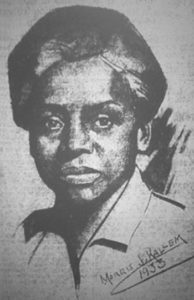
Williana Burroughs
*Williana Burroughs was born on this date in 1882. She was a Black teacher, communist political activist, and politician.
Williana "Liana" Jones Burroughs was born in Petersburg, Virginia. Her mother was a slave; her father died when Williana was four. Her widowed mother left Virginia for New York City, bringing Williana with a sister and a brother, where she worked as a cook. Her mother could not care for her children, so Williana spent the next seven years in the Colored Orphan Asylum in Harlem. Her mother was able to retrieve her three children from the orphanage when Williana was 11.
Young Williana attended public schools in New York, where she was an excellent student. In 1909, Jones married Charles Burroughs, a postal worker, and actor. After graduation, she attended New York City Normal College, known today as Hunter College, where she achieved credentials to become a teacher. In 1910 she obtained her first teaching position, in charge of a first-grade classroom. In 1926, Burroughs moved to P.S. 48 in Queens, New York, where she taught first and second-grade children. She was soon recruited into the New York City Teachers Union, where she was active as part of the Communist-led "Rank and File caucus."
Burroughs joined the Workers (Communist) Party in September 1926. She became active in the campaign for the defense of the Scottsboro Boys. She was chairman of the Blumberg Defense Council, an organization formed to defend Isidore Blumberg, a teacher removed from the New York public school system due to his political views. The Communist Party sent Burroughs to the 6th World Congress of the Communist International in Moscow in the summer of 1928 as a representative of the American Negro Labor Congress, a Communist Party auxiliary group. Burroughs traveled with her husband and her two youngest sons to the convention, with the boys remaining in the Soviet Union to attend school thereafter. Burroughs would not be reunited with them until 1937. Burroughs used the pseudonym "Mary Adams" in the communist movement during the 1920s and 1930s, publishing an article for the party's daily newspaper under that name for May Day1928.
She became prominent within the party organization and was selected as an alternate delegate to the 6th National Convention of the Communist Party USA in March 1929. In 1933 Burroughs spoke out at a meeting of the New York City Board of Education, and in June 1933, Burroughs was dismissed from her post for "conduct unbecoming to a teacher and prejudicial to law and order." After the loss of her teaching position, Burroughs was one of the first women to run for elective office in New York as the Communist Party's candidate for New York Comptroller in the fall of 1933 and the Communist Party's candidate for Lieutenant Governor of New York in 1934. She also ran the Harlem Worker's School from 1933 to 1934. She was regarded as one of the party’s most effective witnesses during the public hearings over the 1935 Harlem Riot.
She returned to the Soviet Union in the spring of 1937, the year of the Great Terror, where she worked as an announcer and editor for the English-language broadcasts of Radio Moscow, the international shortwave news service of the Soviet government. Burroughs remained in Moscow for virtually the rest of her life. In the spring of 1940, she made a request to return to the United States together with her sons but was persuaded to stay owing to the lack of capable Americans remaining in the USSR. The war intervened, and Burroughs and her sons remained in Moscow until 1945, when she finally managed to return to New York with the younger boy.
Williana Jones Burroughs died on December 24, 1945, at the Manhattan home of her friend Hermie Huiswoud, just two months after her return to the United States and barely more than a week before what would have been her 64th birthday. Her son Charles Burroughs, the oldest of the boys left in Moscow, retained his American citizenship and was inducted into the U.S. Army early in 1945. After his military service, he returned to the United States and, in 1961, co-founded the DuSable Museum of African American History in Chicago, of which he remained curator until 1980. A Chicago high school is named after him.
